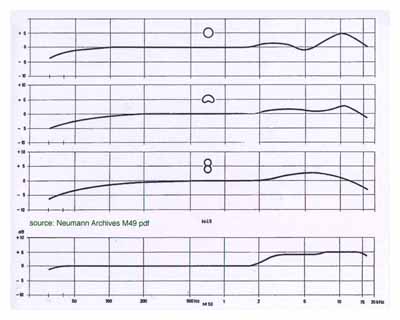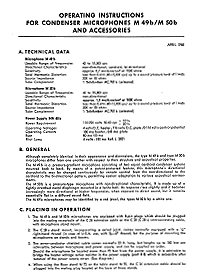
The Neumann M 49,
M 50, and M 249
condenser microphones

The Neumann M 50.
The Neumann M 49 and M 50 condenser mics are studio microphones with excellent characteristics. The M 49c is used in broadcasting, films, disc recording, in post-sync studios, and everywhere good results must be achieved in spite of difficult acoustic conditions. As this microphone can be switched to three different directional characteristics, it can cope with almost any situation likely to arise.
The M 50c is a pressure transducer with omni-directional characteristics only, and has proven to be suitable for recording orchestras in acoustically favorable conditions by the one-mic technique.

A Neumann M 50c (left) and an M 49c.


The M 49 and M 50 frequency responses.
General
Though completely identical in their appearance and dimensions, the type M 49b and type M 50b microphones differ from one another with respect to their structure and acoustical properties.
The M 49b is a pressure-gradient microphone consisting of two equal cardioid condenser systems mounted back to back. By means of a patent-protected feature, this mic’s directional characteristic may be changed continuously by remote control from the non-directional to the cardioid to the bi-directional pattern, which permits an easy adaptation to various acoustical environments.
The M 50b is a pressure-type microphone with non-directional characteristics. It is made up of a tightly stretched metal diaphragm mounted in a lucite ball. Its response rises slightly and it becomes increasingly more directional at higher frequencies when exposed to direct sound, but it remains flat in a diffused sound field.
The M 49b microphones may be identified by a red jewel, the types M 50b by a white one.

Photos courtesy of Michael Farrow.
Mr. Farrow adds:
“Anecdotal information is that fewer than a thousand M 50s were made (I’ve never seen one with a four-digit serial number), and since they are often used in sets of three or five, there just aren’t that many sets around. It’s great that you found a photo of the internal mic showing the mounting sphere. Neumann went through several materials for the diaphragm, starting with PVC which quickly became too brittle, then went to aluminum which was difficult to tension given the metallurgy of the period. After that, I’m told they went to nickel which was used in several of their mics, e.g. the KM 56, and finally Mylar, as in the KM 83.”

The Neumann M 249.
Neumann produced about 2500 M 49s, a popular microphone made from 1949 until 1974. In 1961 Neumann introduced the M 249 for use in broadcast. The difference between the M 49 and the M 249 was the use of a seven-pin Tuchel connector (as used on the U 67) instead of the eight-pin bayonet Tuchel connector used on the M 49 and M 50. This connector was employed as it had superior EMI/RF rejection for use in broadcast situations. In fact, any Neumann microphone that is given a 200 series number was made to broadcast specifications. This mic is also a landmark in microphone design, as it was the first mic to have its polar pattern switchable remotely on its power supply. The M 49 and M 249 are best known for their use on Miles Davis, Barbara Streisand, Duke Ellington, Simon and Garfunkel, and countless other classics. These mics have an incredibly rich and round tone that has the ability to make even harsher sounds much more pleasant and warm.

Download the sales brochure for this mic.
344 kilobytes, eight-page pdf

Download the instructions for this mic.
128 kilobytes, three-page pdf